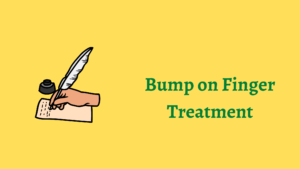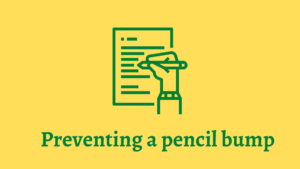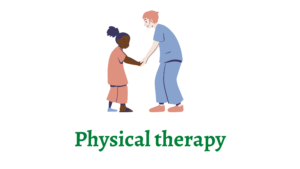
A writer callus on the finger is a thickened area of skin that forms on the finger or fingers that are used for writing. It is caused by repetitive friction or pressure on the skin and is common in writers, musicians, and other individuals who use their fingers for repetitive movements. It is typically not harmful and can be treated by using moisturizing cream or by using a finger cushion. In some cases, if it causes pain or discomfort, it may need to be treated by a doctor.
Writer’s Bump on finger Causes
The main cause of a “writer’s bump” or “typing nodule” on the finger is repetitive friction or pressure on the skin. This can occur when an individual writes or types for long periods of time, causing the skin on the finger to thicken and form a bump. Other potential causes include genetics, underlying medical conditions such as rheumatoid arthritis, and poor posture while typing or writing.
Other factors that can contribute to the development of a writer’s bump include:
- Holding a pen or pencil too tightly
- Using a pen or pencil that is too small or too thick
- Using a computer keyboard with an improper typing technique
- Not taking regular breaks to stretch and rest the fingers
It’s important to note that the bump is not a serious condition and typically does not cause any pain or discomfort. However, in some cases, it may be necessary to see a doctor if the bump is causing pain or if it interferes with the ability to write or type.
Writer’s Bump on Finger Treatment

Treatment for a “writer’s bump” or “typing nodule” on the finger typically involves reducing the friction or pressure on the affected area. Some common treatment options include:
- Using a finger cushion or splint: This can help to redistribute pressure on the finger and reduce friction.
- Applying moisturizing cream or lotion: This can help to soften the skin and reduce thickening.
- Adjusting writing or typing technique: Improving posture, using a larger or softer pen, and taking regular breaks to stretch and rest the fingers can help to reduce pressure on the finger.
- Changing to a different mouse or keyboard: Using an ergonomic keyboard or mouse can help to reduce pressure on the fingers and reduce the risk of developing a bump.
- Physical therapy: in some cases, a physical therapist can help you to improve your technique and reduce pressure on your fingers
If the bump is causing pain or discomfort, or if it interferes with the ability to write or type, a doctor may recommend additional treatment options such as corticosteroid injections or surgery. However, these options are typically only used in severe cases.
It’s important to note that prevention is better than cure, so taking regular breaks, improving your posture, and using the appropriate equipment can help to reduce the risk of developing a bump.
How to get rid of Writer’s Bump on Finger
Here are some steps you can take to get rid of a “writer’s bump” or “typing nodule” on your finger:
- Reduce pressure and friction: Use a finger cushion or splint to redistribute pressure on the finger, and apply moisturizing cream or lotion to soften the skin.
- Change your writing or typing technique: Improve posture, use a larger or softer pen, and take regular breaks to stretch and rest your fingers.
- Use ergonomic equipment: Switch to an ergonomic keyboard or mouse, which can help to reduce pressure on your fingers.
- Physical therapy: A physical therapist can help you to improve your technique and reduce pressure on your fingers.
- Surgery: if the bump is causing pain or discomfort, or if it interferes with the ability to write or type, a doctor may recommend a surgical procedure like excision or shaving of the bump.
It’s important to note that these treatment options may take time to work, and it may be several weeks or months before you notice a significant improvement. It’s also important to be patient and consistent with your treatment plan.
Preventing the bump from coming back is key, by maintaining good posture, using appropriate equipment, and taking regular breaks during writing or typing, you can reduce the risk of developing a bump in the future.
Is Writer’s Callus Dangerous?
A writer callus, also known as a “writer’s bump” or “typing nodule,” is typically not dangerous. It is caused by repetitive friction or pressure on the skin and is common in writers, musicians, and other individuals who use their fingers for repetitive movements.
The callus itself is not harmful, it can be treated by using moisturizing cream or by using a finger cushion. However, in some cases, if it causes pain or discomfort, it may need to be treated by a doctor. In rare cases, if the writer callus becomes infected it could lead to more serious complications.
It’s important to note that if you experience pain, numbness, tingling, or discoloration in the affected finger, you should see a doctor as these symptoms may indicate an underlying medical condition that requires further evaluation and treatment.
In general, a writer’s callus is a benign condition that can be treated easily, and it is important to pay attention to the symptoms and to prevent it by maintaining good posture, using appropriate equipment, and taking regular breaks during writing or typing.
Preventing a pencil bump on your finger

Preventing a “writer’s bump” or “typing nodule” on the finger requires reducing the friction or pressure on the affected area. Here are some steps that can help to prevent the development of a pencil bump on your finger:
1. Use a larger or softer pen.
Using a pen or pencil that is too small or too hard can cause more pressure on the finger. You can use pens or pencils that are more comfortable to hold, such as thicker pens or ergonomic pens.
2. Hold the pen or pencil lightly.
Instead of gripping the pen or pencil tightly, try to hold it lightly to reduce pressure on the finger. This can also help to reduce the development of a bump.
3. Take regular breaks.
Taking regular breaks to stretch and rest your fingers can help to reduce pressure and prevent the development of a bump. Set an alarm to remind yourself to take breaks every hour and take a few minutes to rest your hands and fingers.
4. Use an ergonomic keyboard or mouse.
Using an ergonomic keyboard or mouse can help to reduce pressure on the fingers and reduce the risk of developing a bump. Additionally, switches like Gateron Ink V2 switches can enhance your keyboard experience and contribute to more comfortable and ergonomic usage, further reducing strain on your fingers. An ergonomic keyboard or mouse is designed to reduce strain on the hands and fingers, which can help to prevent a bump from forming.
5. Improve your posture.
Maintaining a good posture while writing papers or typing can help to reduce pressure on the finger and prevent the development of a bump. Make sure your chair and desk are at the right height for you, and that your computer monitor is at eye level.
6. Use a finger cushion or splint.
This can help to redistribute pressure on the finger and reduce friction. Finger cushions or splints are designed to reduce pressure on the finger and are available in various sizes and shapes.
7. Apply moisturizing cream or lotion.
This can help to soften the skin and reduce thickening. If your skin is dry, moisturizing cream can help to reduce the risk of developing a bump.
8. Physical therapy.

A physical therapist can help you to improve your technique and reduce pressure on your fingers. They can show you exercises that can help to strengthen your fingers and reduce the risk of developing a bump.
It’s important to note that preventing a pencil bump on your finger requires consistency and patience. It may take several weeks or months before you notice a significant improvement. Remember that prevention is better than cure, so take the steps to keep your fingers healthy and reduce the risk of developing a bump. Also, it is important to check if the bump is not due to an underlying medical condition, in that case, it is necessary to consult with a doctor.
In addition, it’s a good idea to vary your activities during the day, for example, typing or writing for a long period of time, it’s better to take a break and do other activities that don’t require the use of your fingers. This will help to reduce pressure on your fingers and reduce the risk of developing a bump.
Overall, by implementing these preventative measures, you can take steps to reduce the risk of developing a pencil bump on your finger, and ensure that your fingers stay healthy and comfortable.
Bottom Line
A “writers bump” or “typing nodule” is a thickened area of skin that forms on the finger or fingers that are used for writing or typing. It is caused by repetitive friction or pressure on the skin and is common in writers, musicians, and other individuals who use their fingers for repetitive movements. However, it is typically not harmful, but if it causes pain or discomfort, it may need to be treated by a doctor.
Preventing the writer’s bump requires reducing the friction or pressure on the affected area. To prevent it, you can use a larger or softer pen, hold the pen or pencil lightly, take regular breaks, use an ergonomic keyboard or mouse, improve your posture, use a finger cushion or splint, apply moisturizing cream or lotion, and physical therapy. It’s important to note that preventing a pencil bump on your finger requires consistency and patience, and it may take several weeks or months before you notice a significant improvement. Remember that prevention is better than cure, so take the steps to keep your fingers healthy and reduce the risk of developing a bump.
Thanks for reading!